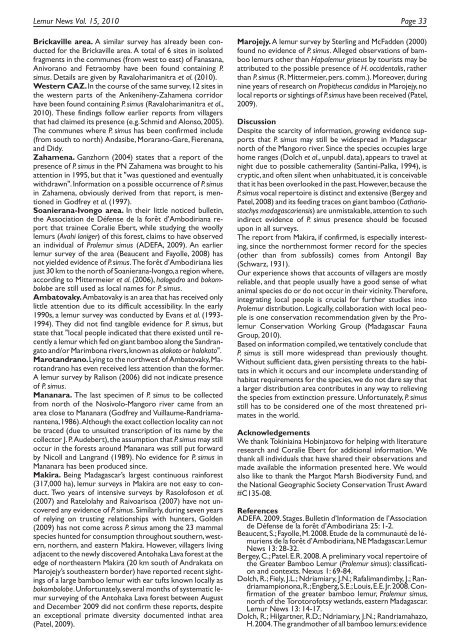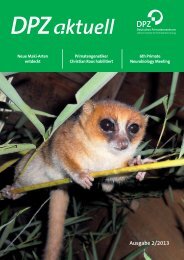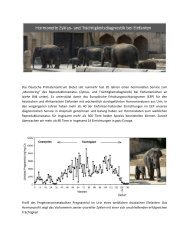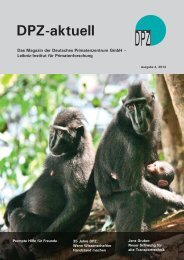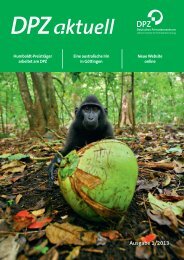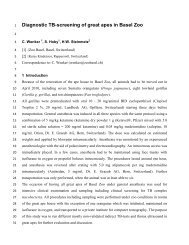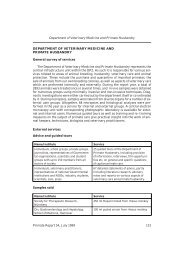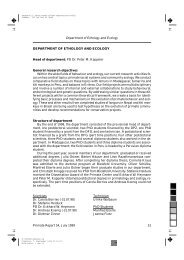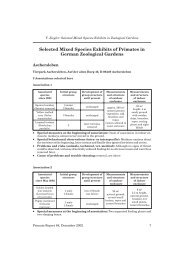Vol. 15 - Deutsches Primatenzentrum
Vol. 15 - Deutsches Primatenzentrum
Vol. 15 - Deutsches Primatenzentrum
You also want an ePaper? Increase the reach of your titles
YUMPU automatically turns print PDFs into web optimized ePapers that Google loves.
Lemur News <strong>Vol</strong>. <strong>15</strong>, 2010 Page 33<br />
Brickaville area. A similar survey has already been conducted<br />
for the Brickaville area. A total of 6 sites in isolated<br />
fragments in the communes (from west to east) of Fanasana,<br />
Anivorano and Fetraomby have been found containing P.<br />
simus. Details are given by Ravaloharimanitra et al. (2010).<br />
Western CAZ.In the course of the same survey,12 sites in<br />
the western parts of the Ankeniheny-Zahamena corridor<br />
have been found containing P. simus (Ravaloharimanitra et al.,<br />
2010). These findings follow earlier reports from villagers<br />
that had claimed its presence (e.g.Schmid and Alonso,2005).<br />
The communes where P. simus has been confirmed include<br />
(from south to north) Andasibe, Morarano-Gare, Fierenana,<br />
and Didy.<br />
Zahamena. Ganzhorn (2004) states that a report of the<br />
presence of P. simus in the PN Zahamena was brought to his<br />
attention in 1995, but that it "was questioned and eventually<br />
withdrawn".Information on a possible occurrence of P.simus<br />
in Zahamena, obviously derived from that report, is mentioned<br />
in Godfrey et al. (1997).<br />
Soanierana-Ivongo area. In their little noticed bulletin,<br />
the Association de Défense de la forêt d’Ambodiriana report<br />
that trainee Coralie Ebert, while studying the woolly<br />
lemurs (Avahi laniger) of this forest, claims to have observed<br />
an individual of Prolemur simus (ADEFA, 2009). An earlier<br />
lemur survey of the area (Beaucent and Fayolle, 2008) has<br />
not yielded evidence of P.simus.The forêt d’Ambodiriana lies<br />
just 30 km to the north of Soanierana-Ivongo,a region where,<br />
according to Mittermeier et al. (2006), halogodro and bokombolobe<br />
are still used as local names for P. simus.<br />
Ambatovaky.Ambatovaky is an area that has received only<br />
little attention due to its difficult accessibility. In the early<br />
1990s, a lemur survey was conducted by Evans et al. (1993-<br />
1994). They did not find tangible evidence for P. simus, but<br />
state that "local people indicated that there existed until recently<br />
a lemur which fed on giant bamboo along the Sandrangato<br />
and/or Marimbona rivers,known as alakoto or halokoto".<br />
Marotandrano.Lying to the northwest of Ambatovaky,Marotandrano<br />
has even received less attention than the former.<br />
A lemur survey by Ralison (2006) did not indicate presence<br />
of P. simus.<br />
Mananara. The last specimen of P. simus to be collected<br />
from north of the Nosivolo-Mangoro river came from an<br />
area close to Mananara (Godfrey and Vuillaume-Randriamanantena,1986).Although<br />
the exact collection locality can not<br />
be traced (due to unsuited transcription of its name by the<br />
collector J.P.Audebert),the assumption that P.simus may still<br />
occur in the forests around Mananara was still put forward<br />
by Nicoll and Langrand (1989). No evidence for P. simus in<br />
Mananara has been produced since.<br />
Makira. Being Madagascar’s largest continuous rainforest<br />
(317,000 ha), lemur surveys in Makira are not easy to conduct.<br />
Two years of intensive surveys by Rasolofoson et al.<br />
(2007) and Ratelolahy and Raivoarisoa (2007) have not uncovered<br />
any evidence of P.simus.Similarly,during seven years<br />
of relying on trusting relationships with hunters, Golden<br />
(2009) has not come across P. simus among the 23 mammal<br />
species hunted for consumption throughout southern,western,<br />
northern, and eastern Makira. However, villagers living<br />
adjacent to the newly discovered Antohaka Lava forest at the<br />
edge of northeastern Makira (20 km south of Andrakata on<br />
Marojejy’s southeastern border) have reported recent sightings<br />
of a large bamboo lemur with ear tufts known locally as<br />
bokombolobe.Unfortunately,several months of systematic lemur<br />
surveying of the Antohaka Lava forest between August<br />
and December 2009 did not confirm these reports, despite<br />
an exceptional primate diversity documented inthat area<br />
(Patel, 2009).<br />
Marojejy. A lemur survey by Sterling and McFadden (2000)<br />
found no evidence of P. simus. Alleged observations of bamboo<br />
lemurs other than Hapalemur griseus by tourists may be<br />
attributed to the possible presence of H. occidentalis, rather<br />
than P. simus (R. Mittermeier, pers. comm.). Moreover, during<br />
nine years of research on Propithecus candidus in Marojejy,no<br />
local reports or sightings of P.simus have been received (Patel,<br />
2009).<br />
Discussion<br />
Despite the scarcity of information, growing evidence supports<br />
that P. simus may still be widespread in Madagascar<br />
north of the Mangoro river. Since the species occupies large<br />
home ranges (Dolch et al., unpubl. data), appears to travel at<br />
night due to possible cathemerality (Santini-Palka, 1994), is<br />
cryptic, and often silent when unhabituated, it is conceivable<br />
that it has been overlooked in the past.However,because the<br />
P.simus vocal repertoire is distinct and extensive (Bergey and<br />
Patel,2008) and its feeding traces on giant bamboo (Cathariostachys<br />
madagascariensis) are unmistakable,attention to such<br />
indirect evidence of P. simus presence should be focused<br />
upon in all surveys.<br />
The report from Makira, if confirmed, is especially interesting,<br />
since the northernmost former record for the species<br />
(other than from subfossils) comes from Antongil Bay<br />
(Schwarz, 1931).<br />
Our experience shows that accounts of villagers are mostly<br />
reliable, and that people usually have a good sense of what<br />
animal species do or do not occur in their vicinity.Therefore,<br />
integrating local people is crucial for further studies into<br />
Prolemur distribution. Logically, collaboration with local people<br />
is one conservation recommendation given by the Prolemur<br />
Conservation Working Group (Madagascar Fauna<br />
Group, 2010).<br />
Based on information compiled,we tentatively conclude that<br />
P. simus is still more widespread than previously thought.<br />
Without sufficient data, given persisting threats to the habitats<br />
in which it occurs and our incomplete understanding of<br />
habitat requirements for the species,we do not dare say that<br />
a larger distribution area contributes in any way to relieving<br />
the species from extinction pressure. Unfortunately, P. simus<br />
still has to be considered one of the most threatened primates<br />
in the world.<br />
Acknowledgements<br />
We thank Tokiniaina Hobinjatovo for helping with literature<br />
research and Coralie Ebert for additional information. We<br />
thank all individuals that have shared their observations and<br />
made available the information presented here. We would<br />
also like to thank the Margot Marsh Biodiversity Fund, and<br />
the National Geographic Society Conservation Trust Award<br />
#C135-08.<br />
References<br />
ADEFA. 2009. Stages. Bulletin d’Information de l’Association<br />
de Défense de la forêt d’Ambodiriana 25: 1-2.<br />
Beaucent,S.;Fayolle,M.2008.Etude de la communauté de lémuriens<br />
de la forêt d’Ambodiriana,NE Madagascar.Lemur<br />
News 13: 28-32.<br />
Bergey,C.;Patel. E.R.2008.A preliminary vocal repertoire of<br />
the Greater Bamboo Lemur (Prolemur simus): classification<br />
and contexts. Nexus 1: 69-84.<br />
Dolch, R.; Fiely, J.L.; Ndriamiary, J.N.; Rafalimandimby, J.; Randriamampionona,R.;Engberg,S.E.;Louis,E.E.Jr.2008.Confirmation<br />
of the greater bamboo lemur, Prolemur simus,<br />
north of the Torotorofotsy wetlands,eastern Madagascar.<br />
Lemur News 13: 14-17.<br />
Dolch, R.; Hilgartner, R.D.; Ndriamiary, J.N.; Randriamahazo,<br />
H.2004.The grandmother of all bamboo lemurs:evidence


